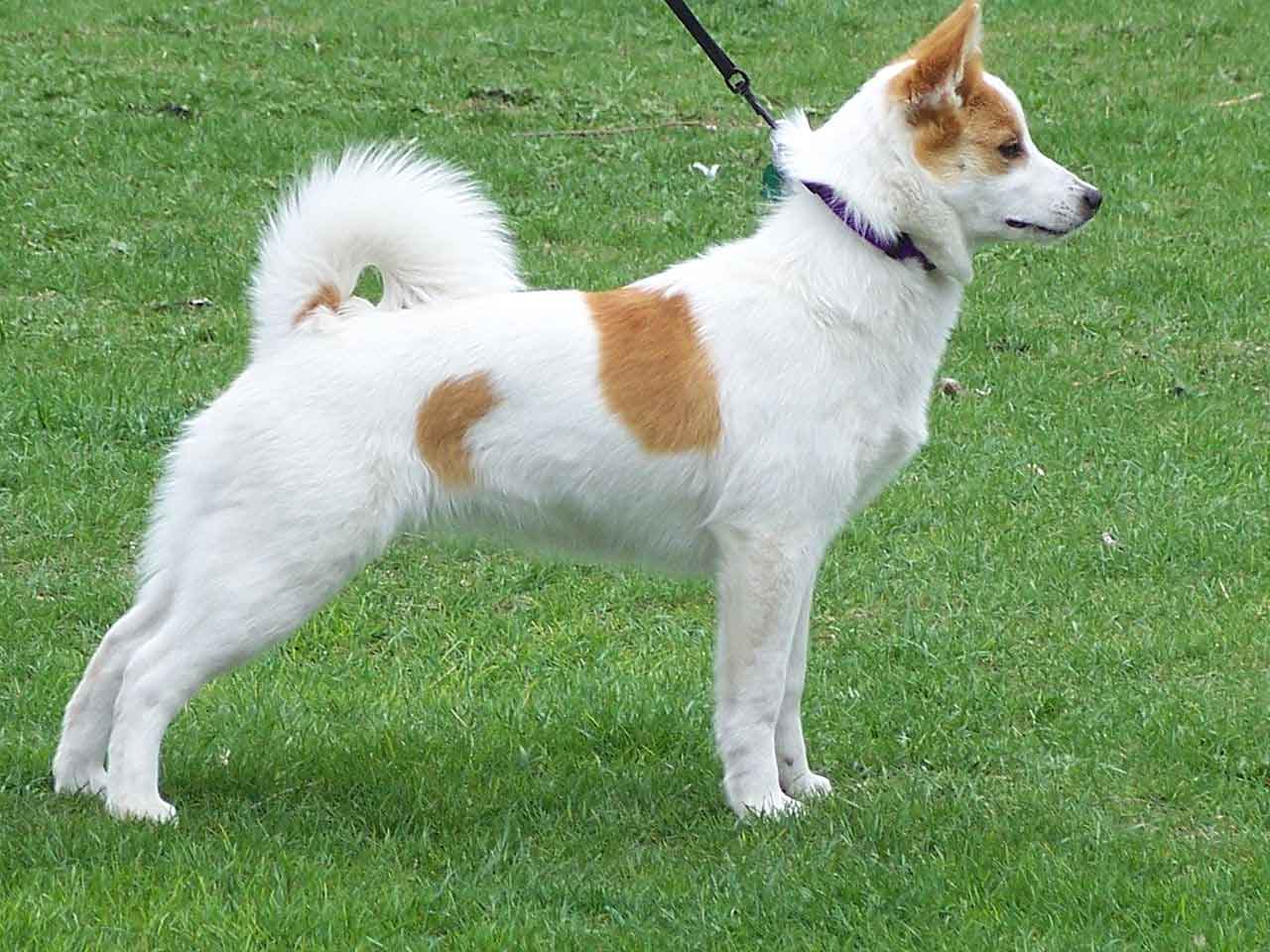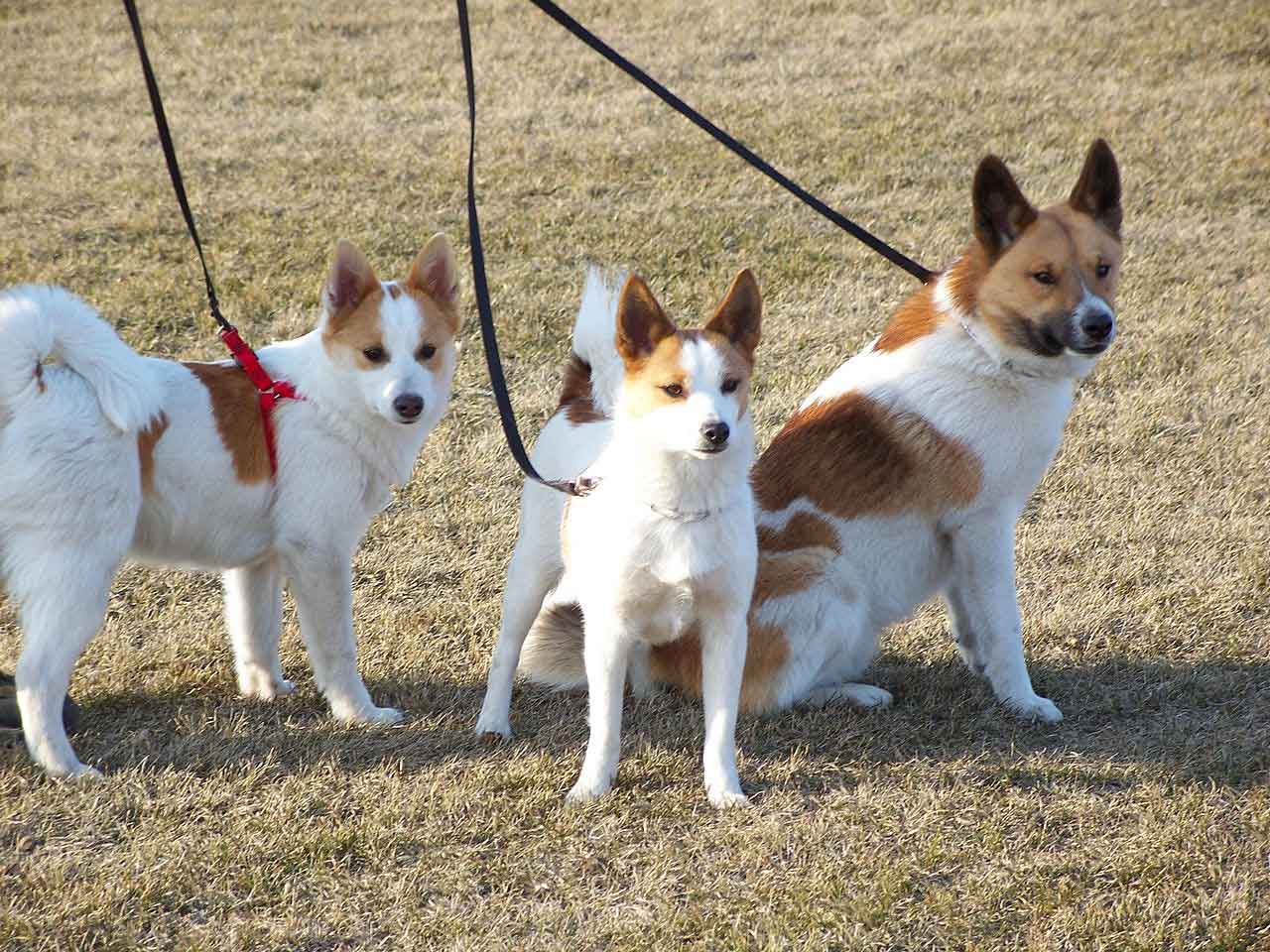Content |
|---|
History
The Norrbottenspets (North Bothnian Country Spitz) probably originates from the small spitz-type Laika that was known to live with hunters in the North Cape area, already in prehistoric times. Small hunting spitz have survived for thousands of years through natural selection – survival of the fittest. In the very harsh and difficult areas of the northern part of the Scandinavian Peninsula, hunting for food and skins was a necessity in order to survive. Precious skins like saber, sable fur and ermine were the only valid currency for centuries. When fur prices fell drastically after WWII, so did the interest in the Norrbottenspets.
The breed disappeared and there were no records for many years, hence the Kennel Club of Sweden (SKK) declared it extinct. But only a decade later news came that true-type specimens had been found living as pets and watchdogs in small homes inland in North Bothnia.. Due to the very dedicated work of a few men, this ancient hunting spitz was saved.
In 1967 the Norrbottenspets was introduced to the Registries and a new standard was drawn up.
Source: https://www.fci.be/en/nomenclature/NORRBOTTENSPITZ-276.html
Physical characteristics
It is a small spitz-type dog with a rather square appearance, compact and plump, with a lean and strong musculature. The bearing is handsome, with head and tail high. The breed has a strong sexual dimorphism, although the ideal specimen for both sexes is a well-characterized small spitz, attentive, good guardian, of harmonious construction and good character.
The skull is sharp, with the ears set high and relatively small, eyes are dark and bright, and express calmness and predisposition towards work.
Ears are slightly below average size with sparse hair and erect bearing. The tail is set relatively high, with fairly tall carriage in a semicircle, with the tip touching the sides of the thighs. When it stretches, must not exceed the tip of the hock.
Fur: hard, short, straight and quite bushy, with fine and dense undercoat. The length varies depending on the area of the body: longer around the neck and on the thighs and shorter on the skull and front of the extremities.
Color: all colors are allowed. The ideal is white with yellow or brownish red spots.
Size: males 45 cm.; females, 42 cm.
Character and skills
The pretty white colored Spitz, of medium size and short hair is very rare in its native country and practically unknown outside of Sweden.
He is an excellent guard with a lot of drive, temperament and stubbornness. With the appropriate physical and mental tension, It is also a nice and friendly companion dog..
As a born hunter, the Norrbottenspets He is very Brave, fearless and alert. He is extremely lively and has a great temperament and self-confidence.. The Norrbottenspets it is very suitable as a guard dog, because it reports everything I miss immediately without being aggressive. In the family he is very sociable, friendly and gentle. But the intelligent and self-assured dog can also be headstrong and needs sensitive training and clear guidance..
The Norrbottenspets he is very docile, but it needs a lot of movement and a lot of demanding and varied activity. The ideal are, for example, tests with companion dogs, sports tournaments with dogs or rescue dog training. Only with the appropriate mental and physical activity the Norrbottenspets It is also a nice and friendly family companion dog.. As a pure house dog or for a life in the city it is not the right dog.
Characteristics "Norrbottenspets"
Coexistence is important that you have with your new friend. Before considering the acquisition of a dog of the breed "Norrbottenspets" you know certain factors. Not all breeds of dogs are apt to live in an apartment, you must take into account his character, their need for exercise, their interaction with other pets, their care and if you have small children, their level of tolerance towards them.
Adaptation ⓘ2,0 of 5 stars (based on 1 review)
|
friendly dog ⓘ2,0 of 5 stars (based on 1 review)
|
hair loss ⓘ3,0 of 5 stars (based on 1 review)
|
|---|---|---|
Affection level ⓘ3,0 of 5 stars (based on 1 review)
|
Need for exercise ⓘ4,0 of 5 stars (based on 1 review)
|
Social need ⓘ3,0 of 5 stars (based on 1 review)
|
Home ⓘ2,0 of 5 stars (based on 1 review)
|
Toilet ⓘ2,0 of 5 stars (based on 1 review)
|
Friendly with strangers ⓘ2,0 of 5 stars (based on 1 review)
|
barking ⓘ5,0 of 5 stars (based on 1 review)
|
Health ⓘ4,0 of 5 stars (based on 1 review)
|
Territorial ⓘ4,0 of 5 stars (based on 1 review)
|
Cat friendly ⓘ2,0 of 5 stars (based on 1 review)
|
Intelligence ⓘ4,0 of 5 stars (based on 1 review)
|
Versatility ⓘ2,0 of 5 stars (based on 1 review)
|
Child friendly ⓘ4,0 of 5 stars (based on 1 review)
|
Surveillance ⓘ4,0 of 5 stars (based on 1 review)
|
joy ⓘ2,0 of 5 stars (based on 1 review)
|
Type and recognitions:
- FCI CLASSIFICATION: 276
- Group 5: Spitz and primitive types
- Section 2: Nordic Hunting Dogs. With proof of work..
Federations:
- – FCI – Group 5 – Section 2 Nordic Hunting Dogs. ⓘ
FCI breed standard "Norrbottenspets"
Use:
hunting dog.
General appearance:
Small Spitz type dog, slightly rectangular, well balanced, With thin muscles andwell developed. Alert holding your head up, fearless and extremely agile attitude. Sexual dimorphism must be clearly visible.
In his capacity as a hunting dog he must be attentive and fearless. He is an enthusiastic dog, live, self-confident, with a friendly disposition. Although the breed is mainly used to hunt large partridges of the bush (Grouse etc.) It is also capable of hunting prey of hair and howler elk.
Head:
Strong ofclean cut, top or side view, gradually tapering towards the nose.
- Skull: Relatively widethe forehead is slightly arched, the upper part of the skull is rather flat.
- Depression links (Stop): Evidentbut only slightly marked.
facial region:
- Truffle: black.
- Snout: Its length is half the length of the head or somewhat shorter. Clearly tapering towards the nose but never pointed.
- Lips: Thin, and tightly fitted.
- Cheeks: Defined.
- Jaws / Teeth: Well developed jaws and teeth. Scissor bite.
EYES: Medium-sized, almond shaped and inserted obliquely.Bright with calm and energetic expression. dark brown color.
EARS: High insertion, upright, slightly larger than medium size, with hard skin, slightly rounded tips.
Neck:
Moderately long, in proportion with the body, dry and muscular, slightly arched, with good scope.
Body:
Cross: Defined.
Back: Short, strong, muscular andelastic.
Pork loin: Short and broad.
Rump: Moderately long and wide, slightly inclined and with well developed musclesand strong.
Breast : Moderately deep and long.The depth of the chest should be approximately half the height at the withers and with well developed back ribs. Seen from the front, the thorax is oval in shape andwith a normal width. Well developed and well defined forechest.
Bottom line and belly: Seen on side, The lower part of the rib cage must be in line with the elbow or barely under it and emerge gently on the belly line. Bellyonly moderately retracted.
Tail:
Proportionally high insertion, carried in a fairly high curve, slightly curled so the tip of the tail touches one side of the thigh. The length of the tail must not reach below the hock. Tail docked is not allowed.Tips
PREVIOUS MEMBERS :
- Blades : Long and wide, With well developed spine and muscles. Glued to the chest and properly oblique.
- Arm : It must be the same length as the scapula, strong, well attached to the chest but allowing freedom of movement and forming a marked angle with the spine of the scapula.
- Elbows : Directed backwards Forearm : Straight, with strong bones, thin but flexible muscles.
- Carpus and metacarpus : Strong, forming a straight line with the forearm, when seen from the front. Seen on side, The metacarpo is slightly oblique.
- Previous feet : Small, strong, directed straight ahead, well arched and closed, with hard, well-developed pads.
LATER MEMBERS : Seen from behind, the hind limbs are parallel.
- Thigh : Proportionally long, forming a right angle with the pelvis. Strong muscles.
- Knee joint : Strong.
- Leg : Form a sharp angle with your thigh.
- Warm-foot joint : Side and front view, is strong.
- Metatarsus : Delgado, elastic and rather long.
- Hind feet : Similar to the previous. Headed straight forward.
Movement:
During the trot and canter, Norrbottenspets should show smooth and regular movements, with great momentum and covering the ground well. In action, The upper line must remain firm and the posterior parallel members.Mantle
HAIR : The hair is hard, short, straight, and rather close to the body, with fine and dense undercoat. Must be short on the muzzle, skull, ears and front of limbs, longer at the nape, back of the thighs and under the tail.
COLOR : All colors are permitted. The ideal color is white with yellow or reddish-brown markings.
Size and weight:
Height to the cross :
Ideal height :
- in males : 45 cm.
- in females : 42 cm..
Fouls:
Any deviation from the aforementioned criteria is considered as a fault and the severity of this is considered to the degree of the deviation to the standard and its consequences on the health and well-being of the dog., and the dog's ability to perform its traditional task.
SERIOUS FAULTS:
- Meat or liver color nose.
- Dental missing except for P1.
- Tan markings.
- Roan or speckled.
FALTAS DESCALIFICANTES:
- Aggressiveness or extreme shyness.
- Any dog showing clear signs of physical or behavioral abnormalities.
- Short tail.
- Males should have two normal-appearing testicles fully descended into the scrotum..
- Only functionally and clinically healthy dogs, with the typical conformation of the breed, should be used for parenting.
The latest changes are in bold.
Alternative names:
1. Nordic Spitz, Norrbottenspitz, Pohjanpystykorva (English).
2. Spitz nordique (French).
3. Norrbottenspets, Pohjanpystykorvat (German).
4. Spitz nórdico (Portuguese).
5. Spitz nórdico (español).

